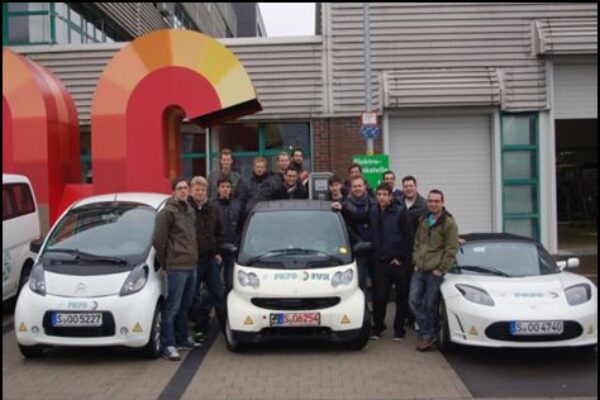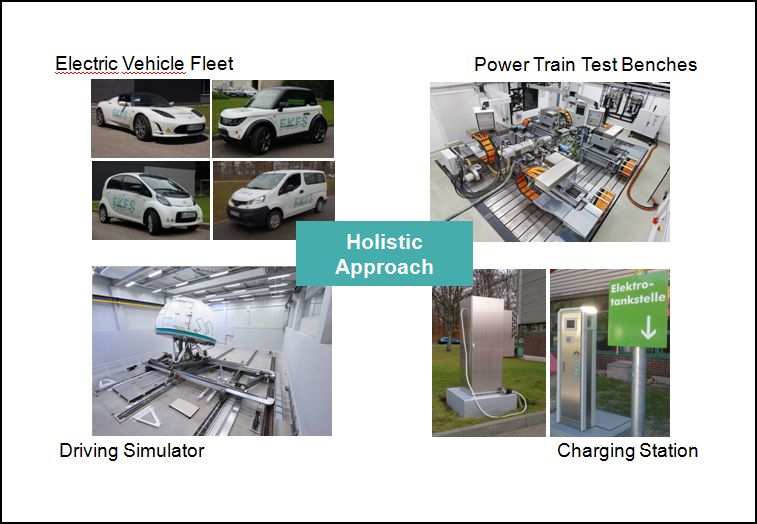
Project e-smart: an e-mobility research platform for students made by students – Part 1
Nowadays, energy economy is one of the most important topics in all areas of technical research, especially in the automotive sector. Dwindling oil supplies and fossil fuels rising prices force automobile manufactures to develop less energy consuming vehicles. Furthermore, proceeding urbanization and a changing in young people’s user behavior require new mobility concepts. Notes like car sharing concepts, smart grid, advanced driver assistance systems or the interactive vehicle are talked of a lot. Independent of which trends will prevail, it is obvious that future mobility will become increasingly manifold, complex and electric.
All this will bear huge challenges to the engineers. Future vehicles complexity will demand for high interdisciplinarity and enhanced teamwork in all stages of product development. To master these challenges universities education plays a major role to teach relevant skills.
This report presents a student project at the Institute for Internal Combustion Engines and Automotive Engineering (IVK) at the University of Stuttgart in which a commercial compact car vehicle with combustion engine was converted to an electric vehicle. The whole process of conversion including planning and specifying the requirements onto to electric vehicle, electric components selection, E/E-architecture design, control software design as well as implementation of hardware and software was done by students of the University of Stuttgart under the supervision of the Research Institute of Automotive Engineering and Vehicle Engines Stuttgart (FKFS) which is in tight cooperation with the IVK.
1. E-Mobility at the FKFS/IVK
The automotive mechatronics departments of the cooperating FKFS and IVK are concerned with all issues of E-Mobility. In several government-funded and industry projects diverse research is carried out using a holistic approach to generate fast and sustainable solutions. The FKFS/IVK offers and uses several facilities for E-Mobility research topics such as a fleet of different category electric vehicles equipped with measurement systems for power flow and vehicle dynamics, a test bench for electric and hybrid power trains as well as batteries and cells, a driving simulator for development of advanced driver assistance systems and a research charging station capable of different kind of AC, DC and inductive charging.

E-Mobility at the FKFS/IVK
2. Project Aims
This university funded project aims students of the University of Stuttgart to convert a commercial compact car vehicle with combustion engine to an electric vehicle. About 20 students with different subject background from mechanical engineering, automotive and motor engineering, electrical engineering, automation engineering and cybernetics started planning the vehicle conversion at the end of 2010. It was aimed to bring students with different knowledge and skills together in order to handle the conversion process complexity. This was necessary since tasks were various. Students specialized in mechanics were required as well as those knowing about electronics and software. All students’ works were supervised by postgraduate employees of the FKFS.
First of all, requirements onto the electric vehicle had to be specified. The main target was to create an open vehicle platform enabling for manifold research topics, especially for the three core research areas: range prediction and optimization by means of intelligent power train control and advanced driver assistance systems, different charging techniques as fast DC charging and comfortable inductive charging besides the common AC charging standards as well as safety which is considered by a high voltage system monitoring, battery cells monitoring and copious diagnosis functions.

Research targets
Regarding the set requirements it was soon clear that the converted vehicle had to be fully controllable by self made software in all stages of driving and charging operation as well as booting and shut down. Based on the considered control functions the students started do specify required measured variables, the related sensors, the rapid control prototyping systems, the control and communication interfaces to the power train and to the on-board and off-board chargers. All necessary hardware components were determined and the E/E-architecture including communication lines and power lines designed. Meanwhile control software was developed, tested in a simulation environment and implemented on the rapid control prototyping hardware.
Finally, the converted vehicle was ready for a first drive with electric propulsion in August 2011. In the meantime, the software was refined and new functions were implemented. Also, the vehicle could show its operational capability when it was driven by about 50 test persons on a 60 km driving cycle in the course of a huge FKFS test person study with wintry conditions on the subject of energy consumption in real-life vehicle operation.
In the future, further sensors and functions will be implemented by new employed students in order to achieve the set targets. The new functions have to tested and evaluated by the students using simulation but also in experiments on public roads.
3. E-Smart

Converted E-Smart
In the following, a short summary of the converted vehicle is given. Starting with some basic vehicle characteristics, its control system is briefly described. Measurement results made on test benches, test tracks as well as on public roads in the course of the test person study are presented. The vehicle presentation is concluded with some notes about the development process using modeling and simulation.
3.1 Vehicle Characteristics
A commercial Smart ForTwo Type 450 with diesel engine rear-wheel drive was selected for basic vehicle. This choice was motivated because several conversion kit suppliers providing electric components fitting the Smart ForTwo exist. The company E-Car-Tech was chosen and provided a suitable battery back of 60 LiFePo4 cells giving in sum up to 13,5 kWh of energy content and fitting into the vehicle’s underfloor. A proper commercial battery management system with control unit and belonging sensors was already included with the battery. Nevertheless, the battery pack was equipped with own sensors to measure each cell voltage and several temperatures for the reason of developing an own battery management using the installed rapid control prototyping system.
A suitable power train including inverter and 30 kW AC induction motor which substituted the diesel engine was also provided by E-Car-Tech. The gear box remained in the vehicle but was locked in the third gear to get an appropriate ratio for the electric motor. Control software and signal interfaces in the inverter were modified to apply for a fully free torque control from outside. This makes the E-Smart’s longitudinal dynamics completely controllable by the self installed algorithms on the rapid control prototyping system which has a signal interface to accelerator and brake pedal to receive the driver’s request. Furthermore, this measure enables for implementation of own developed driving strategies and an arbitrary regenerative breaking strategy. With given power train and battery pack the E-Smart runs up to 120 km/h and offers a driving range between 70 km and 110 km depending on the driver behavior and the environmental conditions.
In order to charge the E-Smart battery, the driver can chose between different sockets and charging techniques. The E-Smart offers three different sockets for conductive power transfer, this is a common camping socket on the rear right side, a Mennekes socket on the rear lift side as well as a combined AC/DC socket on the front. When charging the battery by AC current a 3 kW on-board charger installed in the vehicle’s front will rectify current to DC. Charging the vehicle directly by DC current is possible with the FKFS research charging station, the charging power is limited by the vehicle’s power lines and connectors which are specified for up to 20 kW. In best case, this enables charging the vehicle within half an hour. Third possibility is to charge the battery contactless using the principle of induction and two magnet coils, one installed below the vehicle and the other integrated in the parking of the FKFS research charging station. This technique is currently under development together with the Institute for Electric Energy Conversion at the University of Stuttgart. Operation was already proofed by prototypes, the on- board coil and belonging rectifier will be installed soon. Independent of which technique is used for charging the battery, the control including socket control, communication to the charging station and charging power control is executed by the self installed control system and self made algorithms.


Vehicle conversion and components of the rear side (top) and front (below).
The second part of this article will describe in detail the vehicle control system; measurements, modeling and simulation of the vehicle, and an outlook on future e-car issues.
 If you enjoyed this article, you will like the following ones: don't miss them by subscribing to :
eeNews on Google News
If you enjoyed this article, you will like the following ones: don't miss them by subscribing to :
eeNews on Google News




